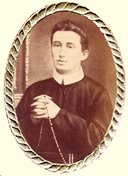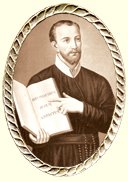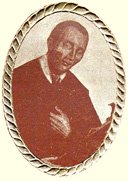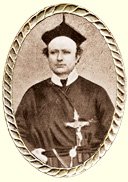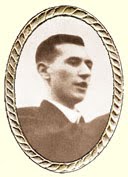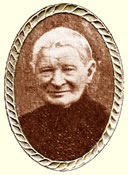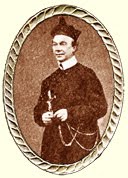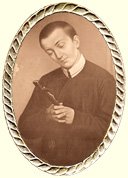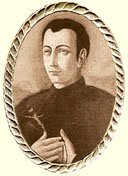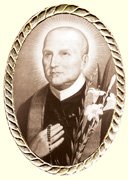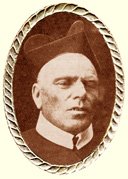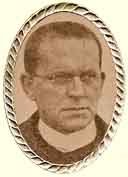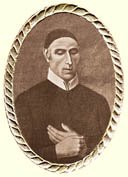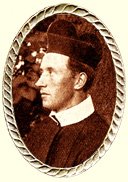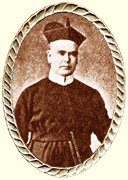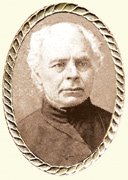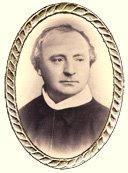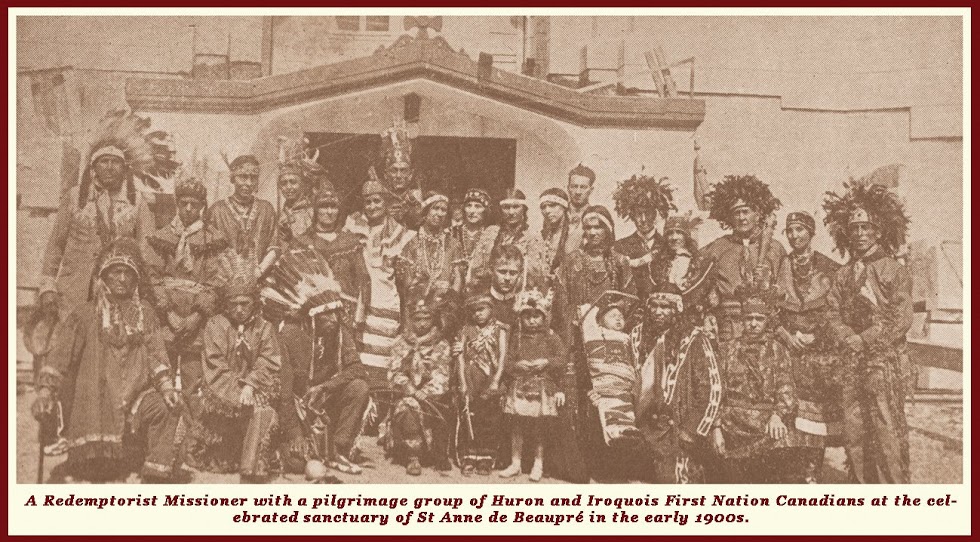Rev. Fr Thomas Edward Bridgett, C.SS.R. (1829-1899)
“Death has removed from the midst of us one whose loss will be widely felt, not only in England, but in other lands. Many of our readers will be anxious to have some details of his life and his last days. Fortunately, we have a short sketch of his early life and conversion from Father Bridgett’s own hand.” From this life we learn that he was born on January, 20th, 1829, in a house attached to his father’s silk mill in Derby.
The Tablet continues: “The most important event of his school life was in 1843, when, at the age of fourteen he was sent to his third school at Tonbridge, in Kent, an old-fashioned Church of England grammar school. Of the head master Father Bridgett says: ‘The head master, Dr. Weldon, a parson, was a worthy man, to whom I owe much. He tried to govern the school on the Rugby system of Dr. Arnold, but like all Protestant systems, it is ineffectual for real moral good.’ The account that Father Bridgett gives of the moral state of the schools to which he was sent, is indeed sad. One cannot help being filled with admiration at the fidelity with which this young boy corresponded, in spite of such adverse surroundings, with the grace now vouchsafed to him. He writes: ‘Still the master had some good influence, and while at that school, I felt, for the first time, religious impressions, and came to think of God and my soul. I went to him one day and told him that I was not baptized and that I wished to be. He gave me some instruction and some leisure time to prepare.’” Father Bridgett mentioned earlier, that his father, having been brought up a Baptist, had none of his children baptized in their infancy.
The writer in the Tablet goes on to relate that in August, 1846, Father Bridgett’s father died suddenly, and that in October of the following year his mother sent him to Cambridge, where he found himself in the midst of the fierce dissensions between High Church and Low, and as he says himself, “I was fairly puzzled.” Then follows an account of his conversion: “The day of grace for him was when he accidentally met with some of Kenelm Digby’s works. ‘From that day my heart was with the Church of the Saints. I hated the isolation and insularity of the Church of England and felt it was a mere sham.’
"At the end of his third year at Cambridge he felt that he could not take his degree, because he could not conscientiously take the Oath of Supremacy repudiating the spiritual power of the Pope. In the vacation he read Newman’s sermon on Faith lately published in Discourses to Mixed Congregations, and was greatly moved by his description of Faith as an absolute surrender of the mind to a living authority, known to be Divine, not a puzzle over documents, with doubt about correct interpretation. Finally, he went to hear Dr. Newman, who was giving his lectures on the ‘Difficulties of Anglicans’ at the London Oratory, King William Street, Strand, and then made up his mind, and was received into the Church by Father Stanton, who is still living at the Brompton Oratory.
"He describes himself going forth after his reception with his shirt front still wet with the Baptismal Water and feeling inclined to laugh for very joy and to say to the people: ‘Now, I am no longer a member of your petty Anglican religion. I belong to the Church of the Apostles, the Fathers and the Saints. St. Francis and St. Dominic would not disown me, and when I go across the sea I shall not be a stranger in Christendom.’
“He added shortly before his death: ‘More than forty years have passed since then, and the same thought and joy are as fresh as ever.’ He continues: ‘I am not attempting here to give any proper account of my inner life; so I will say no more about the history of my conversion than that the main thought that led me to the Faith has been developed in my Ritual of the New Testament, in the chapter on the Real Presence. It was this: If there is a living God, such as the Bible tells us of, then the Catholic Church is God’s dwelling place and God’s organ on earth. Or conversely: If the Catholic Church is to be rejected, a fortiori is the Bible. In two things I was certain they agreed, viz.: in the view they held about God, the living God; and, secondly, in the view about the life of man – the ascetic view I may call it. 'God was a living God, not a theory, or an abstract first cause, or law and order, but a God who made known His Will. His Will was the law of life, and man must mortify his own will to do God’s Will. I often read The Imitation of Christ and The Spiritual Combat. I was sure they held the same view of life as the New Testament. I was sure Protestantism did not, nor the English newspapers, nor the English people as a body.’
"He was baptized as a Catholic, on June 12th, 1850, being twenty-one years old. It is now that we see how faithfully he has corresponded to God’s light, and how deeply he had meditated on the end for which God created man. ‘Having become a Catholic,’ he says, ‘I felt at once that I could most directly and effectually attain the end of life by entering a religious order.’ Father Stanton advised him to make a retreat at the Redemptorists’ House, Hanley Castle. He finally resolved to join the Congregation of the Most Holy Redeemer. He went to St. Trond, in Belgium, for his novitiate, and then for five years to the House of Studies at Wittem, in Dutch Limburg.
"He was ordained Priest on August 4th, 1856. He returned to Clapham the same month. He spent over forty years in England and Ireland as a Redemptorist. During that time he did not give as many missions as most Fathers (1) because he was generally at Clapham, which is not such a missionary house as the others, having a parish attached to it; (2) because he held the office of Rector in various houses during more than thirteen years; (3) because he was continually occupied with retreats to the clergy, clerical students, and religious of both sexes; and, lastly, because of his bad health, which, before many years, began to tell against him. In spite of this he gave about eighty missions in various parts of England and Ireland, and some 130 or 140 retreats of various kinds.
"In speaking of his apostolic labours we must not omit to mention the men’s Confraternity at Limerick, founded by him when Rector there, in January, 1868. One who knew it well, in after years, writes as follows: ‘I had often heard of the wonderful Confraternity of 5,000 men in Limerick, but I never realised what it really was until I was in the midst of them. The large Redemptorist Church could not accommodate more than half at a time. A stranger coming into the church on a Monday evening would be amazed at the splendid meeting of men; the whole church filled, with several sections within the altar rails. When told that it was only an ordinary weekly meeting, and only half the Confraternity, and that if he came the next day, Tuesday, he would see a similar sight, and yet not one man would be the same, it was impossible for him not to feel that throughout the world it would be difficult to find any Confraternity to equal it.’
"Father Bridgett, however, is chiefly known by his writings. It is impossible to give any adequate account of them here. That wonderful sincerity and love of truth that led him through all the trials and dangers which surrounded his boyhood and youth, and finally brought him, in spite of all sacrifices, into the bosom of the true Church, shines forth in all his writings, and made him one of our most trusted leaders. Though an eminent controversialist Father Bridgett was eminently a man of peace, and had an instinctive aversion for the lover of disputes. His honesty as an historian was so well known that it is to be doubted if anyone ever accused him of a suppressio veri except Anthony Froude. Could any historian desire a better eulogium!
"One well qualified to gauge the effect of Father Bridgett’s writings, wrote, on receiving the news of his death: ‘He was one of the best of our captains. I always recognized him as a presence that could be felt in every plane of Church life and counted on. Let us hope that Father Bridgett and his great patron, Blessed Thomas More, will put their hands together and provide a generation of their kind.’ The words of the Holy Ghost might well be applied to him: ‘He sought profitable words, and wrote words most right, and full of truth.’ (Eccles. xii., 10).
“Amidst his own brethren in the Congregation he was looked upon, for the same reason, as the most reliable of counsellors. When the terrible disease that caused his death disclosed itself, he was anointed on October 15th, 1898. God, in His goodness, gave him at first special grace and spiritual joy, which lasted for about six weeks. It seemed to him as if Our Divine Lord was constantly present with him, inviting him to follow Him, as He invited St. Peter to come to Him on the waters. His mind was filled with light which made him realise the truths of faith as he had never done before. He often said that he did not ask to be saved a single pain, but earnestly begged for prayers that he might have the grace to bear his cross and die as a worthy son of St. Alphonsus.
“Later, however, all was changed, and Our Lord allowed him to share in His darkness and dereliction on His cross. His sufferings from the internal cancer were most terrible, and seemed ever on the increase. By God’s merciful Providence during the last few days his physical exhaustion seemed to render him less susceptible of pain, and he breathed forth his soul in wonderful peace at about 4:15 on Friday afternoon, February 17th, 1899.
“Countless letters came to him during his long illness full of tender sympathy and charity from members of his own Congregation and from his many friends outside, which moved him so much that he could scarcely speak of it without tears.”
In a subsequent number the Tablet has an article on “Father Bridgett as a writer”. But to attempt within our limited space to give an account of Father Bridgett’s writings would be to do an injustice to his literary reputation. Even a complete enumeration of his many books cannot be given here. His chief works are concerned with the Ecclesiastical history of medieval England. The following are titles of books familiar to many:
Our Lady’s Dowry
The History of the Blessed Eucharist in Great Britain
The Life of Blessed John Fisher
and what is, perhaps his most widely known work:
The Life of Blessed Thomas More.
Two short publications have a special interest for us; the first: the Retreat to Men, which he gave to the Holy Family Confraternity; this was twice printed and largely sold; the second: An Historical Sketch of the Ancient Monastic Buildings of Adare. †
The Tablet continues: “The most important event of his school life was in 1843, when, at the age of fourteen he was sent to his third school at Tonbridge, in Kent, an old-fashioned Church of England grammar school. Of the head master Father Bridgett says: ‘The head master, Dr. Weldon, a parson, was a worthy man, to whom I owe much. He tried to govern the school on the Rugby system of Dr. Arnold, but like all Protestant systems, it is ineffectual for real moral good.’ The account that Father Bridgett gives of the moral state of the schools to which he was sent, is indeed sad. One cannot help being filled with admiration at the fidelity with which this young boy corresponded, in spite of such adverse surroundings, with the grace now vouchsafed to him. He writes: ‘Still the master had some good influence, and while at that school, I felt, for the first time, religious impressions, and came to think of God and my soul. I went to him one day and told him that I was not baptized and that I wished to be. He gave me some instruction and some leisure time to prepare.’” Father Bridgett mentioned earlier, that his father, having been brought up a Baptist, had none of his children baptized in their infancy.
The writer in the Tablet goes on to relate that in August, 1846, Father Bridgett’s father died suddenly, and that in October of the following year his mother sent him to Cambridge, where he found himself in the midst of the fierce dissensions between High Church and Low, and as he says himself, “I was fairly puzzled.” Then follows an account of his conversion: “The day of grace for him was when he accidentally met with some of Kenelm Digby’s works. ‘From that day my heart was with the Church of the Saints. I hated the isolation and insularity of the Church of England and felt it was a mere sham.’
"At the end of his third year at Cambridge he felt that he could not take his degree, because he could not conscientiously take the Oath of Supremacy repudiating the spiritual power of the Pope. In the vacation he read Newman’s sermon on Faith lately published in Discourses to Mixed Congregations, and was greatly moved by his description of Faith as an absolute surrender of the mind to a living authority, known to be Divine, not a puzzle over documents, with doubt about correct interpretation. Finally, he went to hear Dr. Newman, who was giving his lectures on the ‘Difficulties of Anglicans’ at the London Oratory, King William Street, Strand, and then made up his mind, and was received into the Church by Father Stanton, who is still living at the Brompton Oratory.
"He describes himself going forth after his reception with his shirt front still wet with the Baptismal Water and feeling inclined to laugh for very joy and to say to the people: ‘Now, I am no longer a member of your petty Anglican religion. I belong to the Church of the Apostles, the Fathers and the Saints. St. Francis and St. Dominic would not disown me, and when I go across the sea I shall not be a stranger in Christendom.’
“He added shortly before his death: ‘More than forty years have passed since then, and the same thought and joy are as fresh as ever.’ He continues: ‘I am not attempting here to give any proper account of my inner life; so I will say no more about the history of my conversion than that the main thought that led me to the Faith has been developed in my Ritual of the New Testament, in the chapter on the Real Presence. It was this: If there is a living God, such as the Bible tells us of, then the Catholic Church is God’s dwelling place and God’s organ on earth. Or conversely: If the Catholic Church is to be rejected, a fortiori is the Bible. In two things I was certain they agreed, viz.: in the view they held about God, the living God; and, secondly, in the view about the life of man – the ascetic view I may call it. 'God was a living God, not a theory, or an abstract first cause, or law and order, but a God who made known His Will. His Will was the law of life, and man must mortify his own will to do God’s Will. I often read The Imitation of Christ and The Spiritual Combat. I was sure they held the same view of life as the New Testament. I was sure Protestantism did not, nor the English newspapers, nor the English people as a body.’
"He was baptized as a Catholic, on June 12th, 1850, being twenty-one years old. It is now that we see how faithfully he has corresponded to God’s light, and how deeply he had meditated on the end for which God created man. ‘Having become a Catholic,’ he says, ‘I felt at once that I could most directly and effectually attain the end of life by entering a religious order.’ Father Stanton advised him to make a retreat at the Redemptorists’ House, Hanley Castle. He finally resolved to join the Congregation of the Most Holy Redeemer. He went to St. Trond, in Belgium, for his novitiate, and then for five years to the House of Studies at Wittem, in Dutch Limburg.
"He was ordained Priest on August 4th, 1856. He returned to Clapham the same month. He spent over forty years in England and Ireland as a Redemptorist. During that time he did not give as many missions as most Fathers (1) because he was generally at Clapham, which is not such a missionary house as the others, having a parish attached to it; (2) because he held the office of Rector in various houses during more than thirteen years; (3) because he was continually occupied with retreats to the clergy, clerical students, and religious of both sexes; and, lastly, because of his bad health, which, before many years, began to tell against him. In spite of this he gave about eighty missions in various parts of England and Ireland, and some 130 or 140 retreats of various kinds.
"In speaking of his apostolic labours we must not omit to mention the men’s Confraternity at Limerick, founded by him when Rector there, in January, 1868. One who knew it well, in after years, writes as follows: ‘I had often heard of the wonderful Confraternity of 5,000 men in Limerick, but I never realised what it really was until I was in the midst of them. The large Redemptorist Church could not accommodate more than half at a time. A stranger coming into the church on a Monday evening would be amazed at the splendid meeting of men; the whole church filled, with several sections within the altar rails. When told that it was only an ordinary weekly meeting, and only half the Confraternity, and that if he came the next day, Tuesday, he would see a similar sight, and yet not one man would be the same, it was impossible for him not to feel that throughout the world it would be difficult to find any Confraternity to equal it.’
"Father Bridgett, however, is chiefly known by his writings. It is impossible to give any adequate account of them here. That wonderful sincerity and love of truth that led him through all the trials and dangers which surrounded his boyhood and youth, and finally brought him, in spite of all sacrifices, into the bosom of the true Church, shines forth in all his writings, and made him one of our most trusted leaders. Though an eminent controversialist Father Bridgett was eminently a man of peace, and had an instinctive aversion for the lover of disputes. His honesty as an historian was so well known that it is to be doubted if anyone ever accused him of a suppressio veri except Anthony Froude. Could any historian desire a better eulogium!
"One well qualified to gauge the effect of Father Bridgett’s writings, wrote, on receiving the news of his death: ‘He was one of the best of our captains. I always recognized him as a presence that could be felt in every plane of Church life and counted on. Let us hope that Father Bridgett and his great patron, Blessed Thomas More, will put their hands together and provide a generation of their kind.’ The words of the Holy Ghost might well be applied to him: ‘He sought profitable words, and wrote words most right, and full of truth.’ (Eccles. xii., 10).
“Amidst his own brethren in the Congregation he was looked upon, for the same reason, as the most reliable of counsellors. When the terrible disease that caused his death disclosed itself, he was anointed on October 15th, 1898. God, in His goodness, gave him at first special grace and spiritual joy, which lasted for about six weeks. It seemed to him as if Our Divine Lord was constantly present with him, inviting him to follow Him, as He invited St. Peter to come to Him on the waters. His mind was filled with light which made him realise the truths of faith as he had never done before. He often said that he did not ask to be saved a single pain, but earnestly begged for prayers that he might have the grace to bear his cross and die as a worthy son of St. Alphonsus.
“Later, however, all was changed, and Our Lord allowed him to share in His darkness and dereliction on His cross. His sufferings from the internal cancer were most terrible, and seemed ever on the increase. By God’s merciful Providence during the last few days his physical exhaustion seemed to render him less susceptible of pain, and he breathed forth his soul in wonderful peace at about 4:15 on Friday afternoon, February 17th, 1899.
“Countless letters came to him during his long illness full of tender sympathy and charity from members of his own Congregation and from his many friends outside, which moved him so much that he could scarcely speak of it without tears.”
In a subsequent number the Tablet has an article on “Father Bridgett as a writer”. But to attempt within our limited space to give an account of Father Bridgett’s writings would be to do an injustice to his literary reputation. Even a complete enumeration of his many books cannot be given here. His chief works are concerned with the Ecclesiastical history of medieval England. The following are titles of books familiar to many:
Our Lady’s Dowry
The History of the Blessed Eucharist in Great Britain
The Life of Blessed John Fisher
and what is, perhaps his most widely known work:
The Life of Blessed Thomas More.
Two short publications have a special interest for us; the first: the Retreat to Men, which he gave to the Holy Family Confraternity; this was twice printed and largely sold; the second: An Historical Sketch of the Ancient Monastic Buildings of Adare. †
(Extracts taken from a sketch of his life in The Tablet, February 25th, 1899.)





















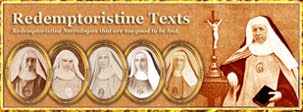
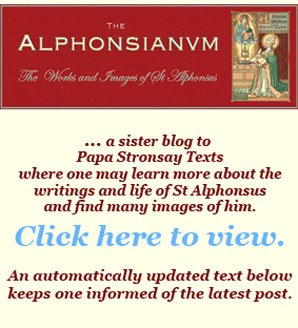.jpg)









